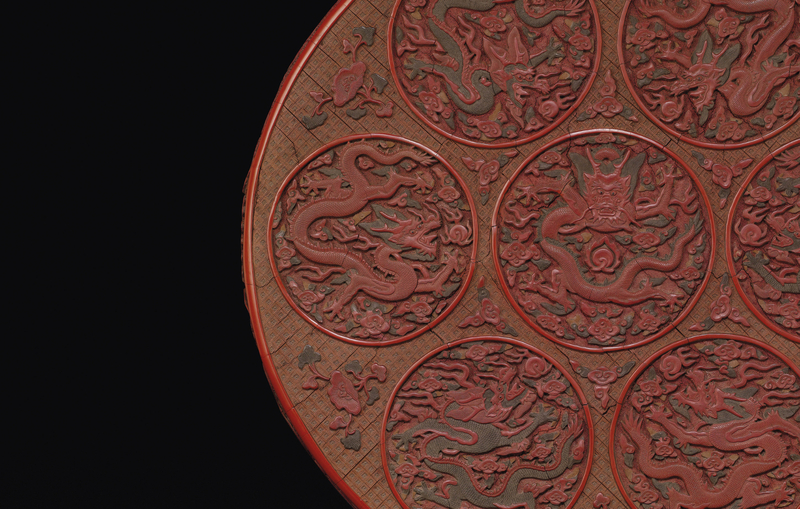A highly important and extremely rare imperial polychrome lacquer 'dragon' box, Wanli period (1573-1619)
Lot 3573. A highly important and extremely rare imperial polychrome lacquer 'dragon' box, Wanli period (1573-1619); 17 1/2 in. (44.5 cm.) diam. Estimate HKD 5,000,000 - HKD 7,000,000. Price Realised HKD 11,300,000. © Christie's Images Ltd 2011.
Superbly carved to the flat cover through layers of cinnabar, green and yellow lacquer with a central roundel containing a fierce full-face dragon, its eyes picked out in black, amidst vaporous ruyi-shaped clouds coiling around a 'flaming pearl', the central roundel encircled by six further roundels depicting similar dragons shown in profile facing the central dominant dragon, their bodies alternately picked out in cinnabar and green, the roundels separated by ruyi clouds and lotus sprigs, the sides of the box and cover with shaped panels depicting two rows of four confronted green and cinnabar dragons separated by the Eight Buddhist Emblems, all against intricate yellow and cinnabar lacquer diaper grounds, the interiors and base lacquered black, Japanese wood box
Property from the Kaisendo museum, Yamagata, Japan.
Literature: Bijutsu Senshu Dai Hachi Kan, Cho Shitsu (Carved Lacquer), 1974, Fuji Art Publications, Japan, no. 61.
Exhibited: Tokyo National Museum, Exhibition of Oriental Lacquer Arts, Tokyo, 1977, illustrated in the Catalogue, p. 253, no. 549.
Note: No other large box of this design appears to be recorded although the design of six dragon roundels around a central dragon in profile can be seen on a large dish bearing a Wanli cyclical date relating to 1592, formerly in the Fritz Low-Beer Collection and now in the Linden Museum, Stuttgart illustrated by M. Kopplin, ed., Im Zeichen des Drachen, Linden-Museum, 2006, p. 169, no. 80 where the current Kaisendo Museum example is discussed. The author discusses the unusual use of seven dragons to top of the dish rather than the usual nine dragons generally favoured by the Imperial court.
It is interesting to note that most other examples of Imperial lacquer of this importance from the late Ming period are inscribed with reign marks and frequently with a cyclical date. It is very likely that the present box originally bore a Wanli mark, and possibly even the same cyclical date as the Linden-Museum example, that has since bee effaced as a result of relacquering to the base.
A number of late Ming lacquer boxes of similar form and size with differing decoration are known. Two Wanli period qiangjin and tianqi decorated lacquer dragon boxes in the Palace Museum, Beijing are illustrated in in Lacquer Wares of the Yuan and Ming Dynasties, The Complete Collection of Treasures of the Palace Museum, Commercial Press, Hong Kong, 2006, pp. 226-227, nos. 178 and 179, measuring 49.2 and 39.5 cm. in diameter respectively. A Wanli period large carved cinnabar lacquer rectangular 'dragon' box and cover inscribed with a Xuande mark in the same collection is illustrated ibid., p. 221, no. 174.
The present box and cover appears to have been inspired both in terms of the form and decoration by early Ming examples such as the Xuande period lacquer 'dragon' box in the Palace Museum Collection, Beijing, illustrated ibid., p. 84, no. 60.
Compare the central full-face dragon with a very similar depiction of a dragon found on a dish with a Wanli jichou cyclical date (1589) exhibited by the Tokugawa and Nezu Museums, 1984, Carved Lacquer, and illustrated in the Catalogue, p. 194, no. 137. The subsidiary dragons shown in profile also compare very closely to a pair of dragons depicted on another Wanli-marked polychrome lacquer dish in the Palace Museum Collection, Beijing, illustrated op. cit., Hong Kong, 2006, p. 210, no. 167.
Christie's. The Imperial Sale, 1 June 2011, Convention Hall

/https%3A%2F%2Fprofilepics.canalblog.com%2Fprofilepics%2F1%2F0%2F100183.jpg)
/https%3A%2F%2Fstorage.canalblog.com%2F03%2F02%2F119589%2F96711876_o.jpg)
/https%3A%2F%2Fstorage.canalblog.com%2F11%2F31%2F119589%2F94773502_o.jpg)
/https%3A%2F%2Fstorage.canalblog.com%2F20%2F83%2F119589%2F94772815_o.jpg)
/https%3A%2F%2Fstorage.canalblog.com%2F26%2F72%2F119589%2F75604929_o.jpg)
/https%3A%2F%2Fstorage.canalblog.com%2F59%2F60%2F119589%2F26458628_o.jpg)





/http%3A%2F%2Fstorage.canalblog.com%2F17%2F63%2F119589%2F128167500_o.jpg)
/http%3A%2F%2Fstorage.canalblog.com%2F80%2F14%2F119589%2F127208807_o.jpg)
/http%3A%2F%2Fstorage.canalblog.com%2F83%2F38%2F119589%2F126548932_o.jpg)
/http%3A%2F%2Fstorage.canalblog.com%2F17%2F40%2F119589%2F126322111_o.jpg)